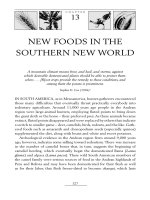NEW WORLD, NEW FOODS
Bạn đang xem bản rút gọn của tài liệu. Xem và tải ngay bản đầy đủ của tài liệu tại đây (223.07 KB, 14 trang )
113
CHAPTER
12
NEW WORLD,
NEW FOODS
The perpetual struggle for room and food.
Thomas Malthus (1798)
MAIZE WAS ONE of the major crops collected as tribute by the Aztecs.
Amaranth was another ( Amaranthus hypochondriacus and A. cruentus – a
third species [A. caudatus] was cultivated in the Andes of South America).
Amaranth was a green treasure that provided edible seeds as well as leaves –
both with good quality protein. Domesticated amaranth was apparently of
considerable antiquity in Mexico and a part of the diet some 5,500 years
ago.
1
The versatile seeds were generally boiled and eaten as a porridge but
could also be made into a beverage, a candy, or could even be popped, and
the hundreds of thousands of bushels of amaranth seed that reached Aztec
granaries each year indicate its widespread cultivation. In addition, the Aztecs
also grew their own amaranth on roughly 75 square miles of chinampas
or fl oating gardens on Lake Texcoco. From Mexico, amaranth cultivation
spread northward to the pueblos of the southeastern United States. It was
domesticated independently in South America .
So why did this valuable plant fall into such disuse that today it is mostly
a curiosity available only in health food stores? The answer generally put
forward is the objection of the Spanish to Aztec religious ceremonies that
employed images made of amaranth dough in what seemed to be a hereti-
cal parody of the Holy Communion. Yet, that may not be the whole story
because a second tribute-crop of the Aztecs has also become obscure. Chía
114
A Movable Feast
(Salvia hispanica) – a relative of sage – is still used today to concoct a
refreshing beverage. In the past, however, the mucilaginous seeds were
roasted and ground into a meal called pinole to become porridge, a main-
stay in many diets.
2
Beans (genus Phaseolus) some species of which may have been domesti-
cated at about the same time as amaranth,
3
constituted another major crop
collected by the Aztecs. As was the case with Old World beans such as favas
and lentils, New World beans – far more numerous than their Old World
counterparts – were gathered long before they were cultivated. Discussion
of the myriad varieties of the domesticated common bean (P. vulgaris),
however, takes us straight into a terminological tangle of names such as
the turtle or black bean, kidney bean (including the white cannellini), and
a whole slew of other conspecifi c beans ranging from what we call chilli,
pinto, cranberry, red, great northern, Lamon, string (snap), and Romano
(Italian green), to other white beans such as pea or navy beans. Dates of
domestication of these many varieties have yet to be established, but when
the Europeans fi rst reached the hemisphere, P. vulgaris – in one or another
of its many guises – was under cultivation from Argentina and Chile in the
south to the St. Lawrence and upper Missouri valleys in the north.
4
In truth, there were probably numerous independent domestications
of the common bean
5
although the epicenters of their cultivation seem
to have been two – the Andean region and Mesoamerica – with legumes
appearing in much of the rest of South and North America just a few cen-
turies before Columbus set sail. Archeological evidence of bean domestica-
tion has promoted a considerable amount of wrangling because the previ-
ously used 14-Carbon dating was contextual, and small objects like beans
tend to move downward and, thus, out of place, in archeological contexts.
However, with the development of 14-Carbon dating by atomic mass
spectrometry, single seeds can be more accurately dated and, not surpris-
ingly, this advance has produced some dates that contradict contextual
dating by a considerable margin. All of this amounts to a tedious way of
saying that the dates we give here for bean domestication are generally
early ones, and domestication may actually have occurred much later.
6
Keeping this caveat in mind, there is evidence to indicate that P. vulgaris
may have been domesticated in the Peruvian Andes as many as 8,000 years
ago and in the Tehuacán Valley of Central Mexico some 1,000 years later.
7
The lima bean (P. lunatus) – the scientifi c name indicating the “lunar-like”
(actually half-moon) shape of some varieties – had its home in the Andean
New World, New Foods
115
region where ancient Peruvians domesticated it perhaps some 5,600 or
more years ago. Interestingly, although lima beans do not show up in Mex-
ico’s archeological record, a smaller cousin, the sieva bean, does. Although
never grown in Peru, it was under cultivation in Mexico and Central Amer-
ica around 1,200 years ago suggesting that the two varieties shared a distant
common ancestor but were cultivated separately.
8
Today the larger limas
are called “Fordhooks” or “butter beans;” the smaller sieva is a “baby lima.”
Pole beans or scarlet runners (P. coccineus), representing the third Amer-
ican bean species, are often cultivated around poles to keep them from
running. Like other beans, these legumes were gathered for eons before
they were domesticated – an event that some evidence suggests may have
taken place as long as 6,000 years ago. There is no question, however, that
pole beans were under cultivation in Mexico by at least 1,300 years ago.
9
The fourth American bean species is the little known tepary bean
(P. acutifolius). Of all the beans it was the most northerly in origin. Domesti-
cated in Mexico approximately 5,000 years ago, it reached the North Ameri-
can southwest some 700 years before Columbus set out on his fi rst voyage.
10
Today teparies are eaten by some Native American groups in northwestern
Mexico and in the American desert southwest. In addition to baking and
boiling them, the beans are toasted or parched, then emptied of their white
powder. This fl our, in turn, is used to make near-instant bean dishes.
11
Squash, although not an Aztec tribute crop, rounded out the vaunted
maize, squash, and bean triad upon which most Mesoamerican diets soon-
er or later rested. Squash was a name supplied by Native Americans and
thereafter applied by North Americans to many members of the genus
Cucurbita, which popular parlance tends to subdivide into squashes, pump-
kins, and gourds.
12
The latter, however, may not be an American native but
rather have African origins – and, according to plant expert Charles Heiser,
fl oated to the Americas (it has been shown that gourds can fl oat in salt
water for upwards of a year).
13
Such a feat, however, does not call into
question the American origin of squashes and pumpkins.
There were at least fi ve separate domestications of squash in the
Americas that gave us the fi ve squash species. But none of these were
initially valued as food. Rather, in the wild, all cucurbits have gourd-like
qualities, and squash cultivation was probably originally aimed at securing
a steady supply of hard, watertight shells to serve as cooking, drinking,
eating, and storage utensils. They were also useful as fl oats for fi shing nets,
ceremonial rattles, and even for helmets and masks.
14
116
A Movable Feast
When squashes were fi rst used as food, it was for their oil-rich seeds and
the tasty yellow fl owers and shoot tips of immature fruits. Their bitter and
stringy fl esh only became edible after a long period of domestication. After
this, however, squashes were regularly boiled and roasted and fi t right in
to the diet.
15
Most varieties of summer squash such as zucchini, yellow, straight
necked, spaghetti, and patty pan squash are members of the C. pepo clan, as
are some winter squashes like the acorn, and most pumpkins. Collectively
C. pepo constitutes the most popular of all squashes today, and this popu-
larity apparently prevailed yesterday as well, because its seeds are the most
common to be found in the archeological record.
16
Arguments have been made for two independent centers of C. pepo
domestication. One of these was in Mexico around 9,500 to 7,500 years ago,
with the plant diffusing into the southwestern United States by around 3,000
years ago. The second was in eastern North America, where C. pepo was under
cultivation between 5,000 and 3,000 years ago and where its ancestors had
long been growing wild. In Florida, for instance, we now know that C. pepo
was present before the fi rst Native Americans moved into the peninsula.
17
This North American center of domestication helps to explain a hereto-
fore puzzling question of why domesticated squashes and pumpkins (from
the Old English “pompion” or “pumpion”) were present in what is now the
eastern United States before maize. Had C. pepo been domesticated solely
in Mexico, then presumably it would have reached the Eastern United
States at about the same time as maize.
18
But Native Americans were prob-
ably not much concerned about the origin of these cucurbits, whose seeds
and fl esh were some of the most valuable foods in their diets.
There are other winter squashes that belong to varieties of C. argyro-
sperma (formerly denominated C. mixta). These were probably domes-
ticated in southern Mexico around 7,000 years ago, although now they
range through an area extending across Mexico and into the southwestern
United States. They are (and presumably were) grown mostly for their
seeds, although some, like the “Green Striped Cushaw” and the “White
Cushaw” have good quality fl esh.
The earliest archaeological remains of C. moschata (butternut squash
is its most familiar representative) have been found close to the inter-
section of the northern and southern hemispheres – in southern Mexico
dating from 7,000 years ago and in coastal Peru from around 5,000 years
ago.
19
Whether these represent two independent centers of domestication
New World, New Foods
117
is unclear. C. moschata entered North America something over 1,000 years
ago, although if it spread throughout the Caribbean before or after the
Spanish arrived is also unclear.
South America is the home of C. maxima, with coastal Peru probably
the center of its domestication some 4,500 to 2,500 years ago. As the sci-
entifi c name implies, these cucurbit representatives were bred by Native
Americans to secure large pumpkins and squashes such as the Hubbard.
Other familiar, if smaller, examples are banana and buttercup squashes.
C. maxima did not spread to Mesoamerica and further north to North
America until after the sixteenth-century conquest of Peru.
A fi nal New World species is the relatively unknown C. fi cifolia – a
squash adapted to high altitudes.
20
Sometimes called the “Malabar gourd”
or the “fi g-leafed gourd,” it was apparently domesticated in northern South
America but subsequently moved northward to become a food for those
living in the highlands of Mexico as well. In the early nineteenth century,
the keeping qualities of C. fi cifolia recommended it for livestock feed dur-
ing long sea voyages and it was used extensively for this purpose in South
Asia where it acquired the “Malabar gourd” moniker.
Not a cucurbit, but a member nonetheless of the New World tribe of
Cucurbitaceae, the chayote or mirliton ( Sechium edule) – also called “veg-
etable pear,” “christophene,” “custard marrow,” and “ chocho” – was domesti-
cated in Mexico and became established in Peru after the conquest before
hiving out to much of the larger world. Its squash-like fruit is generally the
part eaten, although it has a large and starchy root that many fi nd even
more tasty.
21
Chilli peppers (genus Capsicum) and tomatoes ( Lycopersicon esculentum)–
both members of the Solanacae family – originated in South America, where
wild varieties of each are still found. However, the tomato and at least one
chilli pepper species were fi rst domesticated in Mesoamerica. Their seeds
were moved northward in stages; by winds and waves to be sure, and prob-
ably by migrants and sea traders. Mostly, however, it is suspected that they
traveled in the alimentary tract of migrating birds. When dropped, the seeds
were enveloped in plenty of fertilizer, and when those of the cherry tomato
(believed to be the direct ancestor of today’s cultivated tomatoes) landed
in cultivated Mesoamerican fi elds of a tomato relative – the tomatillo or
husk tomato ( Physalis ixocarpa) – they would have been automatically cul-
tivated along with the similarly-sized tomatillos – and thus automatically
domesticated.
22









